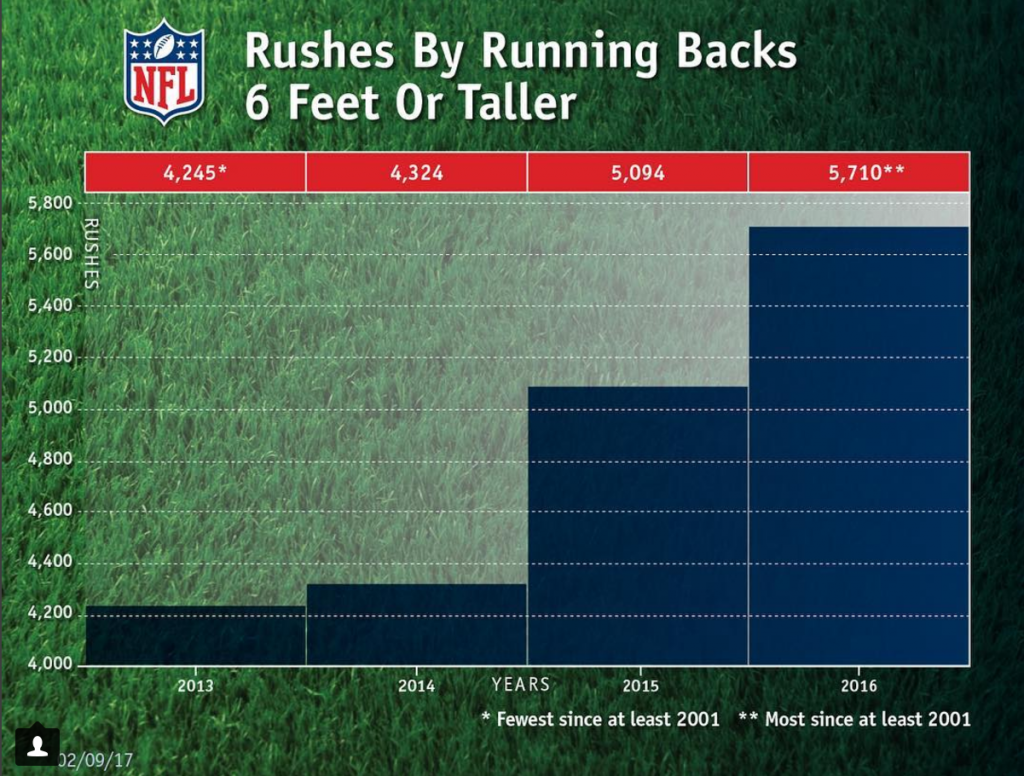Today’s analysis is brought to us from the Instagram page of Tony Khan, the son of Jaguars owner Shad Khan as well as their Senior Vice President for Football Technology and Analytics.
His points are two-fold. The first thing he posted was that: “Since the 2011 NFL season, there has been an increase every year in the number of passing targets for wide receivers under six feet tall, from 2471 in 2011 up to 3817 targets in 2016.”
I believe this only includes wide receivers, so it would be even bigger if third down running backs were included, but either way, a clear trend toward short, quick pass catchers.
The second point he made was: “In the 2013 season, running backs at least six feet tall had the fewest carries in any season since 2001. Since then, the tide has turned, and in each following season, running backs at least six feet tall have had more total carries then in the prior season, and then this past year, the 2016 NFL season, running backs at least six feet tall carried the ball more times than in any season since at least 2001.”
This all lends itself to some bigger points and one that Bill Belichick has a deep understanding of considering the prototypes for his lead power running back position, his third down pass catching back and his slot receivers. In large part, this strategy also works toward exploiting the adjustments that a defense makes and an overall trend of smaller, more athletic linebackers. If they decide to go smaller to defend the pass, you smash them with a big running back. If they go big to stop the run, you’ve got a quick slot receiver who can beat the bigger outside linebacker or safety you’ve put out there. Chris B. Brown talks about how college football sees creativity at the schematic, system level, but in the NFL it’s all about creating mismatches and advantages for yourself to exploit whatever the defense does.
Belichick understands that bigger running backs provide someone who can accomplish the objective of at least four yards on first down to keep your offense ahead of the sticks and in a high probability situation to extend the drive, then use those short receivers to increase that probability of a first down through their ability to get open quickly and catch a high percentage of passes. We’ve seen Belichick use short pass catchers to move the ball in his last two Super Bowl victories to the point that it almost feels like Danny Amendola, with just 443 total receiving yards in their two Super Bowl seasons, is a Patriot solely for use during the playoffs.
In Super Bowl 49 against the Seahawks, Edelman, Vereen and Amendola received 31 of Tom Brady’s 50 targets and caught 80.6% of those for a stat line of 25 catches for 221 yards (7.1 yards per target) and two touchdowns during a game where the Pats were only able to run for 57 yards on 21 carries. Against the Falcons, again against Dan Quinn’s defense, the Patriots were able to gain 104 yards on 25 carries, but the short passing game was a vital part of their comeback and their Super Bowl record 37(!) first downs. Those 37 first downs helped the Patriots run 93 plays to Atlanta’s 46, which helped them wear out the Falcons defense in the later stages of the game. Brady threw the ball 63 times and 43 of those went to James White (16), Edelman (13), Amendola (11) or Dion Lewis (3). Those four players under six foot tall caught a lower rate of 65% of those balls, Edelman caught just five of 13 targets, and combined for 28 catches for 277 yards (6.4 ypt) and the team’s two receiving touchdowns for the game. White also added two touchdowns on the ground to go with his one through the air.
Along with the other great athletes the Patriots have catching the football, this strategy helped them lead the NFL with 6.34 yards after catch per completion, which is increasingly important in a league that’s spreading the defense out and creating one-on-one open field opportunities to make a player miss and turn a four yarder into a forty yarder. This trend will continue to grow along with a trend towards big, athletic tight ends who can create YAC themselves, excel on short-to-intermediate passes, and get open for touchdowns in the redzone. Short receivers, tight ends, third down running backs and one-dimensional power rushers are also inexpensive compared to the prototypes at wide receiver and running back, which is one of the core things the Patriots have understood and utilized to create a team that can compete on a yearly basis through a repeatable salary cap formula.
The objective of football is to move the chains consistently as a means to move the ball down the field to score touchdowns. A strategy the includes a big, powerful running back to keep you ahead of the chains on first and second down, then for third and short yardage and goal line situations, plus a slew of short, quick receivers to optimize a high percentage passing system is, judging by Belichick’s success, the most efficient way to accomplish the objective of scoring touchdowns and creating a roster that can be maintained for a decade and a half. This is a trend and strategy to keep an eye on this offseason.
Zack Moore is a writer for OverTheCap.com, author of the upcoming book titled, “Caponomics: The Process For Building Super Bowl Champions,” and NFLPA Certified Agent. You can follow him on Twitter @Zack_OTC.

